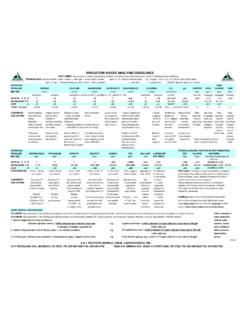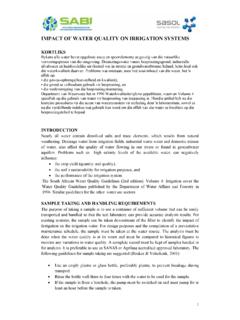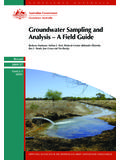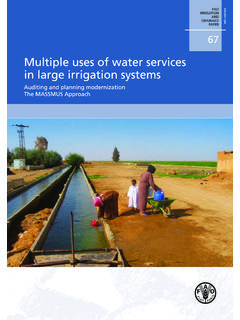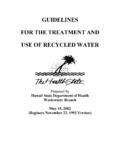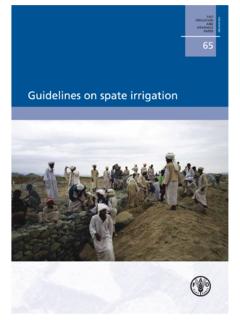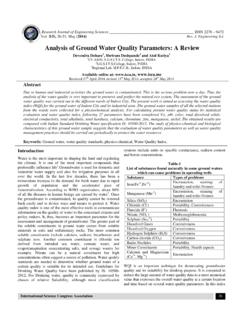Transcription of Special Theme – Environment and Health …
1 Special Theme Environment and Health Guidelines for the microbiological quality of treated wastewater used in agriculture: recommendations for revising WHO guidelines Ursula J. Blumenthal,1 D. Duncan Mara,2 Anne Peasey,3 Guillermo Ruiz-Palacios,4 & Rebecca Stott5. Three different approaches for establishing guidelines for the microbiological quality of treated wastewater that is reused for agriculture are reviewed. These approaches have different objectives as their outcomes: the absence of faecal indicator organisms in the wastewater, the absence of a measurable excess of cases of enteric disease in the exposed population and a model-generated estimated risk below a defined acceptable risk.
2 If the second approach (using empirical epidemiological studies supplemented by microbiological studies of the transmission of pathogens). is used in conjunction with the third approach (using a model-based quantitative risk assessment for selected pathogens) a powerful tool is produced that aids the development of regulations. This combined approach is more cost-effective than the first approach and adequately protects public Health . The guideline limit for faecal coliform bacteria in unrestricted irrigation (41000 faecal coliform bacteria/. 100 ml) is valid, but for restricted irrigation 4105 faecal coliform bacteria/100 ml is recommended when adult farmworkers are exposed to spray irrigation .
3 A limit of 4103 faecal coliform bacteria/100 ml is recommended if flood irrigation is used or children are exposed. The guideline limit for nematode eggs for both types of irrigation is adequate except when conditions favour the survival of nematode eggs and where children are exposed; in these cases it should be reduced from 41 egg/l to egg/l. Keywords: water microbiology, standards; Enterobacteriaceae; maximum allowable concentration; agriculture;. World Health Organization; guidelines. Voir page 1113 le re sume en franc ais. En la pa gina 1114 figura un resumen en espan ol. Introduction in many developing countries the use of untreated wastewater is effectively unregulated.
4 During the past decade, there has been growing Here we discuss the different approaches that concern that the world is moving towards a water have been used to establish or evaluate guidelines on crisis. Water is increasingly scarce in dry climate the microbiological quality of treated wastewater that regions (for example, Africa and South Asia), and is used to irrigate crops. We also review the evidence there are major political implications for the scarcity from epidemiological, microbiological and risk of water in some regions (for example, the Middle assessment studies published since the 1989 WHO. East).
5 Issues of both water quantity and quality are of guidelines (Table 1) and make recommendations for concern. The reuse of wastewater is one of the main the revision of these guidelines taking this new options being considered as a new source of water in evidence into account (1). regions where water is scarce. The standards required for the safe use of wastewater and the amount and type of wastewater treatment needed are contentious. The cost of treating wastewater to conform to high Approaches to setting microbiological standards can be so prohibitive that microbiological guidelines There are currently several alternative approaches to 1.
6 Senior Lecturer, Department of Infectious and Tropical Diseases, establishing microbiological guidelines for reusing London School of Hygiene and Tropical Medicine, Keppel Street, London WC1E 7HT, England (email: wastewater. These have different outcomes as their Correspondence should be addressed to this author. objectives: the absence of faecal indicator bacteria in 2. Professor, School of Civil Engineering, University of Leeds, Leeds, the wastewater, the absence of excess cases of enteric England. disease in the exposed population and a model- 3. Research Fellow, Department of Infectious and Tropical Diseases, generated risk which is below a defined acceptable risk.)
7 London School of Hygiene and Tropical Medicine, London, England. 4. Professor and Head, Department of Infectious Diseases, National The absence of faecal indicator bacteria Institute of Nutrition, Mexico City, Mexico. 5 in the wastewater Research Fellow, Department of Civil Engineering, University of Portsmouth, Portsmouth, England. With this approach, there should be no detectable indicators of faecal pollution in the wastewater. This is Ref. No. 00-0741. 1104 # World Health Organization 2000 Bulletin of the World Health Organization, 2000, 78 (9). Guidelines for the microbiological quality of treated wastewater used in agriculture Table 1.
8 1989 WHO guidelines for using treated wastewater in agriculturea(1). Category Reuse Exposed Intestinal Faecal Wastewater conditions group nematodesb coliforms treatment expected (arithmetic (geometric to achieve mean mean no. the required no. of eggs per 100mlc) microbiological per litrec) guideline A irrigation of crops Workers, 41 4 1000 A series of stabilization likely to be eaten consumers, ponds designed to uncooked, sports public achieve the microbiological fields, public parksd quality indicated, or equivalent treatment B irrigation of cereal Workers 41 No standard Retention in stabilization crops, industrial crops, recommended ponds for 8 10 days fodder crops.
9 Pasture or equivalent helminth and and treese faecal coliform removal C Localized irrigation of None Not applicable Not applicable Pretreatment as required crops in category B by irrigation technology if exposure to workers but not less than and the public does primary sedimentation not occur a In specific cases, local epidemiological, sociocultural and environmental factors should be taken into account and the guidelines modified accordingly. b Ascaris and Trichuris species and hookworms. c During the irrigation period. d A more stringent guideline limit (4 200 faecal coliforms/100 ml) is appropriate for public lawns, such as hotel lawns, with which the public may come into direct contact.
10 E In the case of fruit trees, irrigation should cease two weeks before fruit is picked, and no fruit should be picked off the ground. Sprinkler irrigation should not be used. based on the premise that it is impractical to monitor ricted irrigation (that is, for uses that include crops reclaimed water for all pathogenic microorganisms of likely to be eaten uncooked), no detectable faecal concern and that the use of surrogate parameters, such coliform bacteria are allowed in 100 ml (compared as faecal indicator organisms, is acceptable. Faecal with the 1989 WHO guidelines of 41000 faecal coliforms'' are the indicator bacteria most commonly coliform bacteria/100 ml), and for irrigation of used in discussions of wastewater reuse.










